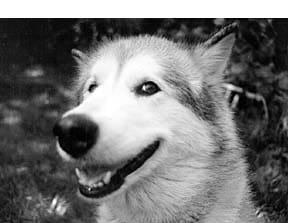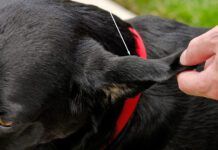She’s The Boss!
I own two beautiful Rottweilers, a male and a female. They are uncle and niece. I’ve had the male from birth; he’s now four years old, has the most outstanding personality, and his temperament is excellent. He gets along with everyone, he’s obedience trained, and there just isn’t enough I could say about him.
A couple of years ago I decided to purchase his niece, a neutered female. She is also obedience trained. Initially, the two got along as if it were meant to be.
I treat each dog equally, but as time has passed, the female has grown more aggressive and possessive about everything. At two years old, she is now a real bully. I have to feed them separately, because she gulps her food down, and then eats his, too. I have to put her in a pen while he eats.

Recently, she also began growling at me while we play. I do scold her, and my male comes rushing in as soon as she tries this. Until this, I never had fear of or mistrust of my dogs; I knew what to expect. But now I don’t feel very comfortable playing with her and rolling in the grass.
I’ve tried spending more time with her than with my male, so she wouldn’t be jealous, but even this doesn’t work. She is still a bully when the male is around. My male is so laid back, he just lets her bully him, or he walks away. Is this a very bad behavior problem? I love my babies, and would do anything for them. But is it too late to correct this behavior at her age?
-Brenda Johnson
Orwell, OH
We directed this question to Dr. Ian Dunbar, a veterinarian and dog trainer residing in Berkeley, CA. Dr. Dunbar is the founder of the Association of Pet Dog Trainers, the creator of the K9 Games, and is well-known for his renowned Sirius Puppy Training program, which he describes in his popular books and instructional videos. Dunbar also recently released two new videotapes on dog aggression.
Over the 20-plus years that I’ve been teaching dog training, I’ve heard countless people say, “my dogs fight all the time; they’re trying to kill each other!” It’s normal for people to have this reaction to their dogs’ fighting; a dog fight, whether it is for real or for play, is a very scary thing to look at and to listen to. However, without discounting the potential seriousness of the situation, let me assure you that these fights usually look and sound worse than they are.
In any situation where dogs are not getting along, in order to give an accurate prognosis for the possibility that they will eventually work things out, I need to know the answers to two very simple questions. When these are answered, I can confidently predict, in the majority of cases, whether you have no real problem at all or whether you have a very, very serious problem. The two questions are: How many fights have the dogs had? And how many times did you have to take one of the dogs to the vet? (That is, did one dog ever puncture the other one?) The answers will determine the dogs’ “bite-to-fight” ratio.
Ironically, the higher the number of fights the dogs have had, the better the prognosis tends to be, because, obviously, if they’ve had a lot of fights, the fights can’t be that serious. By a “fight,” I mean a full contact altercation where the dogs are putting their teeth on each other with a lot of noise and a lot of scuffling. It’s very, very scary to look at and listen to, as I said. But usually there is no damage done.
The second question is: How many times have you had to take the dog to the vet? Or, how many times did one dog puncture the other? In probably 99 percent of cases involving dog-on-dog aggression, the answer to this question is “Never!” In fact, in the vast majority of all cases of dog-on-dog aggression, the answers to both my questions are, “How many fights? Lots of them. Usually ranging from 12 to 20.” and “How many times did one dog puncture the other dog’s skin? Never!”
When I hear these answers, what I know is that, despite all outward appearances, these dogs have wonderful bite inhibition, established during puppyhood in their puppy classes and playing with their littermates. They may be a pain in the butt. They may be cantankerous. They may be obstreperous. But they are certainly not trying to kill each other; if they are, they simply aren’t very good at it. And so in that case – lots of fights and no skin punctures – the prognosis is excellent. Just leave the dogs alone.
Males and females
As yet, it sounds like your female is just bullying the male; no actual fights have erupted yet. This is more common than you’d think. What you describe in your letter sounds like absolutely normal behavior between a female and a male dog.
I did research on this for nine years at the University of California at Berkeley. We watched dogs develop their hierarchies, and observed that the process is very different for males and females.
Male dogs see things in terms of a very precise social hierarchy. There are no ifs, ands, or buts. There is a very precise ladder with the top dog at the top going down to the underdog at the bottom. This is established during development and any argument is pre-settled according to the dog’s rank in the hierarchy.
When females come in, they immediately make amendments to the simple male hierarchical rule. The first amendment is, “I have it and you don’t.” The second one is, “If you have it, I want it.” It is not an unusual occurrence at all for a very low ranking female to easily keep a bone away from a very high ranking male. Males like hierarchy and order and the females just mess it all up.
I’m sorry if I sound biased, but my heart goes out to the male dog. Any middle-aged or older male dog that has the misfortune to be living in the same house as a young bitch – spayed or not – is going to suffer.
But don’t worry about the male too much; if it bothers him that much, eventually, he’ll tell the female, “Just leave it.” But most of the time they can’t be bothered; it’s as if they almost enjoy being hen-pecked. If the dogs have lots of scuffles and disagreements, but no damage has ever been done, I would just leave the dogs to work it out.
However, if these disagreements are really a problem for you, you can make some changes. That’s what I’ve done in my home, because, I, too, have a dog and a bitch who argue sometimes. The bitch is a pain in the butt, there is no question about it. The male is the most beautiful male dog known to dog-kind. He is an utter gentleman, respected by everyone who comes to my house — except for my Malamute bitch, who bullies him all the time. So, occasionally, they have little quarrels, and because they both have a good position in our little “pack,” and because I know they would never hurt each other, I allow them about three seconds to work it out. If it’s not over in three seconds I just send both dogs outside. I tell them, “Go outside! I don’t want to listen to this noise.” This usually ends the argument – or at least removes whatever it was that they were fighting over, whether it was the best spot or the best toy in the room.
Growling at YOU
Now, if the arguments between the dogs were the only problem, I’d be done already. But I think the REAL problem is something else, just as it is something else in most of the aggressive dog cases I’m called in to help solve. The significant part of the problem is the dog growling at you.
You’re not alone. Most of the time, when a dog-on-dog aggression case is presented to me, it is portrayed as a problem of horrific dog fights. “They’re trying to kill each other! They fight all the time!” the person tells me. And after trying to establish whether the prognosis is good, about 20 minutes into the discussion, the owner will casually say, “And last time I tried to break up their fight, the dog bit me and sent me to the hospital.”
A far more serious problem
In my view, all the time spent talking about fighting dogs is a waste of time, because, usually, it’s not really a problem. But the issue of the dog being aggressive to a person is very serious, indeed. This is what we need to direct our attention to.
It’s serious, but the prognosis is excellent. It’s a very predictable problem, especially with Rottweilers, which are very vocal dogs. There are two breeds of dogs that really stand out in my mind as being very talkative or growly, and those are Rottweilers and Malamutes. When I used to teach puppy classes, we would be filled up with Rottweilers and Malamutes, these being two of my favorite breeds. And I would not let anyone leave class unless they had taught their dogs to growl on command and to shush on command.
Here is the reason: There is nothing that will unnerve people more than a dog such as a Rottweiller growling at them. And when dogs get to be about one to two years old, they start trying to assert themselves, and growling is one of their first attempts at this, so you had better know how to deal with it. First, do a quick risk inventory. Are you actually in danger? Does this dog mean something nasty? If you think so, you should contact an experienced dog trainer to help you work through the problem.
Actually, if you are really afraid of your dog – even if you do not feel you are in immediate danger – you might consider hiring a trainer to help you. Nothing will spook your dog more than you being scared. You can actually get into a serious situation if she’s growling and you are acting a little scared. It’s hard for a dog to tell the difference between a scared person and an angry one; it’s close to the same vibration. (I actually think that is the cause of a lot of relationship breakdowns, whether they are between dogs and humans or between humans and humans. We often assume someone is being nasty or aggressive when they’re really just fearful and defensive.)
However, if you are still have some confidence in the dog, try this next set of exercises, which are designed to confirm whether or not you are in control. When your dog shows you that she is still willing to comply with your commands – showing that you are in control – this will build your confidence.
These procedures should resolve the situation very quickly. However, if the situation does not improve, or if it worsens, consult with an experienced trainer right away.
Establishing control
Check that you are in control by running the dog through her most basic commands. If she does come and sit and lie down, she is demonstrating her willing compliance; she is demonstrating that you are in control.
These basic responses need to be emblazoned on the dog’s brain, as if they were branded there. The way I train dogs to do that is very simple; it can be done in a week. I do this by suspending all regular meals for the dog, and instead, hand feeding the dog pieces of kibble from her bowl, one piece at a time, for following my commands. Hand-feeding (“lure-reward training”) is really the best and fastest way to train a dog. If you are in any way worried about this process, you can put on really thick gloves, but you have to hand-feed. Come. Sit. Down. Piece of kibble. Come. Sit. Down. Piece of kibble.
You can even do this when you are in one of the situations where the dog is growling at you. When she growls, stop whatever you are doing and move away from the dog. Then say, “Come here! Sit! Down!” If she concentrates on the come, sit, and the down, the odds are she will stop growling. So this is the way you ask a dog, “Hey, are we really losing it here? Do you really mean that growl or am I still in control?” You just test it. Come here. Sit. Down.
At the same time that you are reinforcing her most basic commands, start handling the dog more, petting and hand feeding her. Even this is to be a training situation: stroke, kibble, stroke, stroke, kibble, stroke, stroke, stroke, kibble. Don’t automatically assume that dogs like stroking and patting. Not even all people do! But you can train dogs to enjoy being handled and man-handled.
As your dog progresses, start to play with her again. There are lots of kinds of play. You can teach her to retrieve a tennis ball or a Frisbee, or play tug-of-war, but at this point, don’t get on the ground. A human on the ground presents a completely different sort of stimulus picture to the dog than one standing up. So play these games, and continue practicing the dog’s important commands: Come, sit, down.
Growl and shush on cue
Once you have established that you have basic control, train the dog to growl on command. I know what you are thinking. “You must be crazy to train the dog to growl on command!” But the reason I do it is that I actually want to teach the dog to shush, to stop growling. And the worst time to teach the dog to stop growling is when she wants to growl because she is upset; it’s a poor training scenario. The best time to teach the dog to shush and stop growling is when she never wanted to growl in the first place! So we put growling on cue.
Since we are a little worried about this dog at the moment, I’d do this with someone else present. Work with just one dog at a time, with the other dog put outside or somewhere else. Put the dog’s dinner somewhere up high, or give it to your friend to hold. Then, get down on the ground and growl and play with the dog and say, “Come on! Speak! Speak! Speak!” As soon as the dog growls, say, “Oh, she’s a good girl!” and offer her a treat.
After some success with this, change to this. Say, “Speak! Speak!” As soon as the dog growls, say, “Oh, that’s a good girl! That’s a good girl! Shush!” and then reach for the kibble and show it to the dog. As soon as you say “Shush!” the dog will sniff the kibble and be quiet. If she doesn’t, don’t give her the kibble. Wait for her to stop growling before you give her the kibble.
The next couple of times I would do it like this: I would say, “Speak!,” get the dog all riled up, have her growl, and then say, “Good dog, there’s a good dog. Shush! Stand up! Come here! Sit! Down!” And then give her the kibble.
Unbidden growling
Now you have both the growl and the shush on cue. But what about when the dog growls when you don’t want her to? The most common scenario is when the dog growls when you are playing. As I said before, this is a very natural phenomenon, especially for the very vocal Rottie. But if the dog growls at you without you requesting it, you can simply say “Shush!,” stop playing, say “Finished,” and walk out of the room. What a punishment! The dog will soon work that one out. The dog just lost you. I used to do this with my first Malamute and that became the one word he never wanted to hear. “Finished” meant that he had really blown it by getting too excited and ignoring an important command.
But if you say “Shush!” and the dog shushes, make sure you continue playing. If you stop playing, even though the dog stopped growling, you’ve effectively punished the dog when she did the correct thing. This nonsensical treatment will undermine all your training work.
If all is still going well (and I expect it will), as you feel more confident, you can play some games with her on the ground. Go ahead and give her the command to growl while you play; there’s nothing inherently wrong with growling in and of itself! As I said before, it’s natural for dogs to growl while they play! Tell her she’s a good dog, and, occasionally, stop the play and check your basic control. Shush! Come! Sit! Down! And then play some more!
If arguments break out between your dogs while you are playing with one or the other, remember what I said about my two dogs’ disagreements. I count to three, and then suspend all fun and ask the dogs to go outside. Just like kids fighting in front of their parents, after getting dismissed a few times to sort things out for themselves, they’ll quickly learn to control themselves, at least while they are in front of you!
Also With This Article
Click here to view “Positive Methods for Obedience Control”





